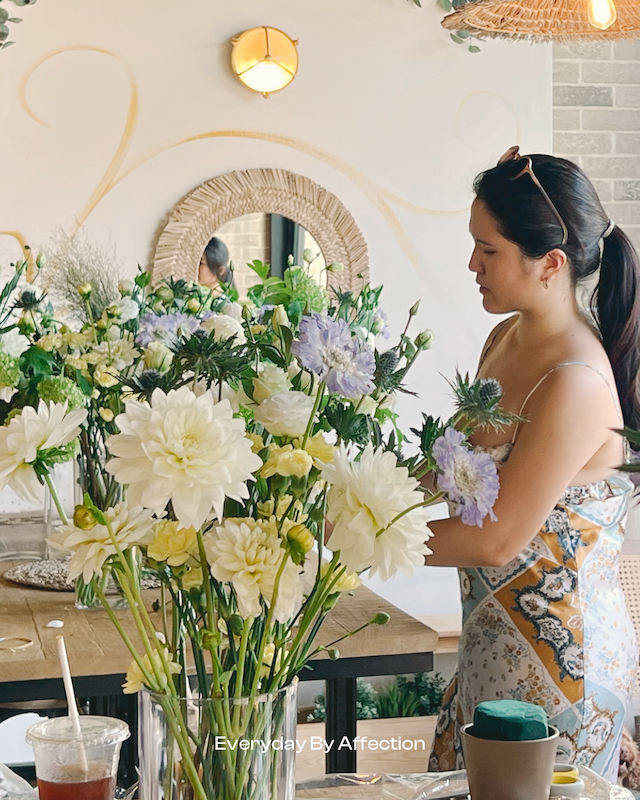How to Become a Florist: Essential Knowledge for Aspiring Florists 🌸💐
If you have a passion for flowers, creativity, and an eye for design, becoming a florist could be the perfect career for you. Floristry offers the chance to express artistic talent while working with beautiful, natural materials to bring joy to others. Whether you want to start your own floral business or work for an established florist, there are some essential skills and knowledge you’ll need to succeed. This guide will help you understand the key steps to becoming a professional florist and what it takes to thrive in the floral industry.
Looking for a comprehensive floristry career course for beginners?
Book Now with our Career Bootcamp hosted by Everyday By Affection.

1. Understand the Florist's Role 🌿
Before diving in, it’s important to understand what florists actually do. Florists are more than just flower arrangers—they are artists, business managers, customer service experts, and often, event planners. As a florist, you’ll be responsible for:
- Creating floral arrangements: Designing bouquets, centerpieces, and floral displays for weddings, events, or everyday use.
- Sourcing materials: Finding the right flowers, foliage, and accessories for each project.
- Caring for flowers: Keeping flowers fresh and vibrant through proper storage and handling.
- Customer service: Helping clients choose the perfect arrangements for their needs and budget.
- Managing a business: Handling inventory, sales, marketing, and logistics (especially important if you run your own shop).
2. Learn Basic Floral Design Skills 🎨
Floral design is at the core of a florist’s job, so learning the principles of flower arranging is essential. Some key design skills include:
- Color theory: Understanding which colors complement each other, creating balance and harmony in your designs.
- Flower selection: Knowing which flowers are in season, how they pair together, and what each flower symbolizes.
- Arrangement styles: Mastering different types of arrangements, such as hand-tied bouquets, vase arrangements, wreaths, and garlands.
- Proportions and balance: Ensuring each arrangement has the right mix of height, fullness, and balance.
If you’re new to floristry, consider taking a floral design course to learn these skills hands-on. There are plenty of online and in-person workshops available, from beginner to advanced levels, to help you build a solid foundation in floral design.

3. Get Familiar with Flower Varieties and Care 🌷
To be a successful florist, you’ll need to become an expert on different types of flowers, plants, and greenery. Understanding how to care for each type is crucial to ensuring your creations look fresh and beautiful for as long as possible.
Some important aspects to consider include:
- Flower types: Learn the names, growing seasons, and characteristics of popular flowers like roses, lilies, peonies, and dahlias, as well as lesser-known varieties.
- Flower care: Know how to properly store and condition flowers, including trimming stems, changing water, and using flower food to keep blooms fresh.
- Longevity: Understand which flowers are more durable and long-lasting, and which are more delicate and short-lived.
- Sourcing: Build relationships with local wholesalers, growers, and markets to source high-quality flowers at the best prices.

4. Gain Business and Retail Skills 📊
Floristry is a business, whether you’re working in a shop or running your own, so having a basic understanding of business management is crucial. Here are some essential business skills you’ll need:
- Inventory management: Track your stock of flowers and supplies to avoid waste and ensure you’re always prepared for new orders.
- Sales and pricing: Learn how to price your arrangements based on material costs, labor, and market demand. Being able to accurately estimate the cost of custom orders is important for profitability.
- Customer service: Developing great customer relationships is key to building a loyal client base. You’ll often be working with customers during special moments—such as weddings, birthdays, or funerals—so empathy and attention to detail are important.
- Marketing: Promoting your services through social media, websites, or local advertising is essential for growing your business. Share your floral designs through Instagram, Pinterest, and other visual platforms to attract new customers.

5. Stay Up-to-Date on Trends and Styles 🌸
Floristry, like fashion, evolves with trends. To remain competitive and offer your clients fresh, exciting designs, it’s essential to stay up-to-date on the latest floristry trends. Some recent trends include:
- Sustainable floristry: Using locally sourced or organic flowers, eco-friendly packaging, and reusable containers.
- Minimalist arrangements: Simple, elegant designs with fewer flowers and more emphasis on natural elements like branches or foliage.
- Bold color palettes: Vibrant, unexpected color combinations are becoming more popular in weddings and events.
Keeping an eye on trends and experimenting with new styles will keep your offerings fresh and appealing to a broad range of clients.
6. Build Experience and Your Portfolio 📸
Experience is key in the floral industry. Start by working in a local flower shop to get hands-on practice with flower arranging, customer service, and day-to-day operations.
As you gain experience, build a portfolio of your work to showcase your designs. This could be a physical portfolio or a digital one you share on social media or your website. High-quality photos of your floral arrangements can attract new clients and give them confidence in your skills.
Volunteer to design flowers for friends' events or local community functions to build experience and create a diverse portfolio. The more you practice, the more your skills will improve, and the more comfortable you’ll become as a florist.
7. Consider Certification or Formal Education 📜
While formal education isn’t always necessary to become a florist, earning a floral design certification or taking specialized courses can boost your credibility and skillset. Certification programs cover advanced floral design, business management, and horticulture, giving you a competitive edge and greater confidence as a professional florist.
8. Start Networking and Building Relationships 🤝
Floristry is a highly networked business. Build relationships with other florists, event planners, and local businesses to help grow your brand and gain more clients. Collaborate on weddings, corporate events, or community projects to increase your visibility and showcase your talents.
Attend floral industry events, floral design workshops, and trade shows to meet other professionals, stay current with industry developments, and keep learning new techniques and trends.

Final Thoughts 🌼
Becoming a successful florist requires a mix of creativity, business acumen, and hands-on experience. By learning the essentials of floral design, flower care, and business management—and staying attuned to industry trends—you’ll be well on your way to thriving in the floral industry.
Whether you dream of owning a flower shop, specializing in event floristry, or simply bringing beauty into people’s lives through your work, the world of floristry is a rewarding and fulfilling career path. So go ahead, cultivate your skills, and let your creativity bloom!
Everyday By Affection hosts comprehensive floristry career courses for beginners and aspiring florists. Click the links below to book your next classes!

